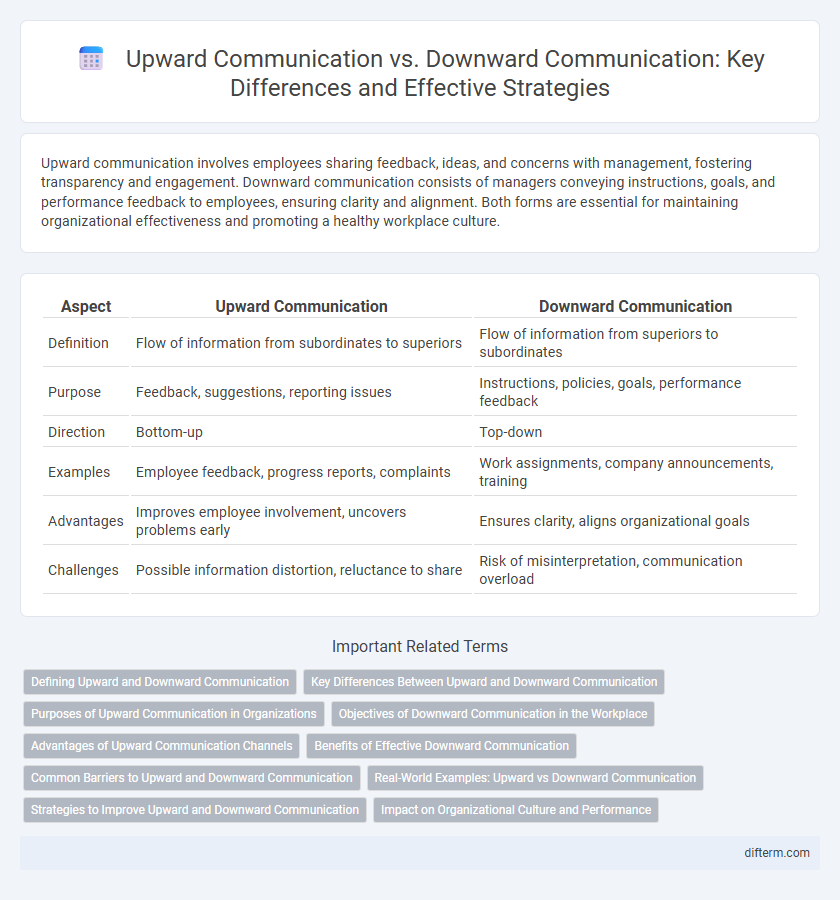Upward communication involves employees sharing feedback, ideas, and concerns with management, fostering transparency and engagement. Downward communication consists of managers conveying instructions, goals, and performance feedback to employees, ensuring clarity and alignment. Both forms are essential for maintaining organizational effectiveness and promoting a healthy workplace culture.
Table of Comparison
| Aspect | Upward Communication | Downward Communication |
|---|---|---|
| Definition | Flow of information from subordinates to superiors | Flow of information from superiors to subordinates |
| Purpose | Feedback, suggestions, reporting issues | Instructions, policies, goals, performance feedback |
| Direction | Bottom-up | Top-down |
| Examples | Employee feedback, progress reports, complaints | Work assignments, company announcements, training |
| Advantages | Improves employee involvement, uncovers problems early | Ensures clarity, aligns organizational goals |
| Challenges | Possible information distortion, reluctance to share | Risk of misinterpretation, communication overload |
Defining Upward and Downward Communication
Upward communication refers to the flow of information from subordinates to supervisors, enabling employees to share feedback, report progress, and express concerns. Downward communication involves the transmission of information from management to employees, including instructions, policies, and organizational goals. Effective communication within organizations depends on balancing these two channels to ensure clarity and responsiveness.
Key Differences Between Upward and Downward Communication
Upward communication involves the flow of information from subordinates to superiors, enabling feedback, reporting, and employee insights, whereas downward communication transmits directives, policies, and motivational messages from management to staff. Key differences include the direction of information flow, purpose--upward communication focuses on feedback and problem-solving, while downward communication emphasizes instructions and organizational goals. The speed and formality also vary, with downward communication typically being more formal and structured compared to the often informal and slower nature of upward communication.
Purposes of Upward Communication in Organizations
Upward communication in organizations serves to relay employee feedback, report progress, and highlight challenges to management, fostering transparency and informed decision-making. It enables employees to express concerns, share ideas, and provide insights from frontline experiences, enhancing organizational responsiveness. This communication flow supports continuous improvement by aligning management strategies with operational realities and employee needs.
Objectives of Downward Communication in the Workplace
Downward communication in the workplace aims to convey organizational goals, policies, and procedures from management to employees, ensuring alignment and clarity in task execution. It facilitates the dissemination of instructions, performance feedback, and motivational messages to enhance productivity and employee morale. Effective downward communication supports consistency and control, promoting a unified organizational culture.
Advantages of Upward Communication Channels
Upward communication channels enhance employee engagement by providing a platform for feedback, ideas, and concerns to reach management, fostering a culture of transparency and trust. These channels improve decision-making accuracy as leaders gain firsthand insights from frontline employees who directly interact with customers and processes. Furthermore, upward communication helps identify problems early, enabling proactive solutions and reducing potential risks within organizational operations.
Benefits of Effective Downward Communication
Effective downward communication enhances employee clarity by providing clear instructions and expectations, which increases productivity and reduces errors. It fosters organizational alignment by disseminating company goals, policies, and updates efficiently, ensuring all team members understand their roles within the larger mission. Consistent downward communication also boosts employee morale and engagement by offering timely feedback and recognition, promoting a positive workplace culture.
Common Barriers to Upward and Downward Communication
Common barriers to upward communication include fear of reprisal, lack of trust, and limited access to decision-makers, which hinder employees from sharing honest feedback. Downward communication faces obstacles such as message distortion, information overload, and lack of clarity, resulting in misunderstandings and reduced employee engagement. Addressing these barriers requires fostering an open organizational culture and implementing clear, concise communication channels.
Real-World Examples: Upward vs Downward Communication
Upward communication in organizations involves employees providing feedback, reports, and suggestions to management, exemplified by frontline workers submitting performance data via digital dashboards. Downward communication flows from managers to staff, such as executive teams disseminating company goals and policy updates through corporate emails or town hall meetings. Real-world examples include a retail store implementing customer service feedback (upward) and a manufacturing plant enforcing safety protocols through supervisor briefings (downward).
Strategies to Improve Upward and Downward Communication
Effective strategies to improve upward communication include creating open feedback channels, encouraging employee participation during meetings, and implementing anonymous suggestion systems to capture honest input. Enhancing downward communication involves clear, concise messaging through multiple platforms, regular updates from leadership, and training managers in transparent communication techniques to ensure alignment across all organizational levels. Organizations that invest in these strategies foster a collaborative environment where information flows seamlessly both from employees to management and vice versa.
Impact on Organizational Culture and Performance
Upward communication fosters employee engagement and trust, enhancing organizational culture by encouraging feedback and innovation, which leads to improved decision-making and performance. Downward communication provides clear directives and expectations, establishing structure and consistency that drive efficiency and goal alignment. Balancing both communication flows is essential for cultivating a collaborative culture and optimizing overall organizational effectiveness.
upward communication vs downward communication Infographic

 difterm.com
difterm.com